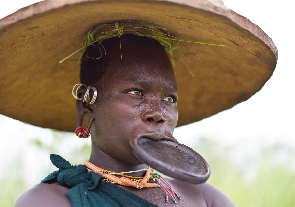There’s no denying that advancements made in technology have a pervasive influence on nearly every facet of modern-day living. But, that notwithstanding, there still exists sections of the global population who hold on dearly to cultural practices in their most ancient forms. A prime example of where to find typical examples of such a people is in the Southern Ethiopian regions near Lake Turkana and the Lower Omo Valley. The Mursi, Suri, and Mekan peoples are the three ethnic groups that make up the Surma people. The cultures of the Suri and the Mursi are comparable. The size of their lip plate determines how beautiful their women are. Southern Sudan and southwest Ethiopia are both home to the Surma tribe. Females who are in their teenage years undergo lip stretching surgery, which entails extracting their lower teeth to make room for a lip plate, which grows in size year after year until it reaches an amazing size. Some of the men engage in a similar ear practice. They also scar their “stick fighters,” or warriors, since they believe that the more scars they have, the more appealing they are to the tribe’s female members. When a girl reaches the age of 15 or 16, her lower lip is sliced (sometimes by her mother) and kept open by a wet plug while it heals. The girls will determine how far the lip should be extended. Frequently, the excruciating procedure lasts for several months. These lip plates typically measure between 4 and 25 centimeters and are made of wood or clay. Two to four teeth would need to be removed before the lip plate could be fitted. When a mother reaches adolescence, she typically undergoes this lip-plating procedure. A ceramic disc is inserted after the cut to expand the lip; it stays in place until the initial cut heals before being replaced with a second, somewhat bigger disc. Young married ladies and unmarried females are more likely to wear lip plates than older married women with children. They are typically worn during significant rites like marriages, offering men meals, and milking cows. Girls who are single and have enormous labels may choose to wear them anytime they are out in public. It is customary for a lover or husband to wait until his girlfriend’s lip has completely healed before having sex with her. There are several interpretations of the lip plate. First of all, it is a beautiful emblem. Secondly, because it is proudly worn when serving the husband meals, it symbolizes a commitment to him. Since a woman’s exterior beauty is thought to diminish after her husband’s death, the lip plate is removed if he passes away. Last but not least, the plate serves as a potent symbol of Mursi identity. Without it, they run the risk of appearing to belong to a different tribe. Some of the men engage in a similar practice. They also scar their warriors, known as “stick fighters,” because it is thought that the more scars they have, the more appealing they are to the tribe’s female members. A girl’s self-esteem is raised by the distinct perception of the lip plate. In addition to using incisions and sometimes painted patterns to decorate their skin, women can increase their worth by increasing the size of their lip plates. Because it implies that the father will receive more cows when it comes time to pay her dowry, the practice is regarded seriously, especially by the parents. A Suri or Mursi woman’s dowry typically ranges from 40 cattle for the smaller plate to 60 cattle for the larger plate, therefore any man who must marry one must be well-off.
Africa News of Sunday, 23 October 2022
Source: face2faceafrica.com

















